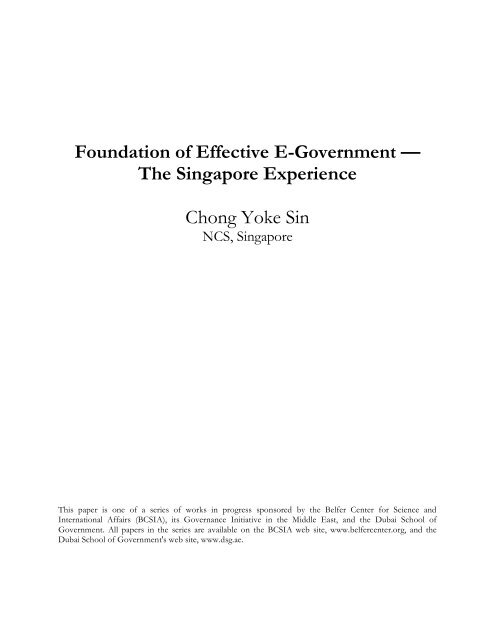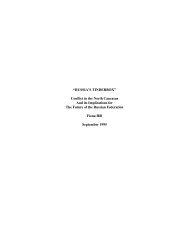Foundation of Effective E-Government ? The Singapore Experience ...
Foundation of Effective E-Government ? The Singapore Experience ...
Foundation of Effective E-Government ? The Singapore Experience ...
You also want an ePaper? Increase the reach of your titles
YUMPU automatically turns print PDFs into web optimized ePapers that Google loves.
<strong>Foundation</strong> <strong>of</strong> <strong>Effective</strong> E-<strong>Government</strong> —<br />
<strong>The</strong> <strong>Singapore</strong> <strong>Experience</strong><br />
Chong Yoke Sin<br />
NCS, <strong>Singapore</strong><br />
This paper is one <strong>of</strong> a series <strong>of</strong> works in progress sponsored by the Belfer Center for Science and<br />
International Affairs (BCSIA), its Governance Initiative in the Middle East, and the Dubai School <strong>of</strong><br />
<strong>Government</strong>. All papers in the series are available on the BCSIA web site, www.belfercenter.org, and the<br />
Dubai School <strong>of</strong> <strong>Government</strong>'s web site, www.dsg.ae.
<strong>The</strong> E-<strong>Government</strong> Iceberg<br />
<strong>Foundation</strong> <strong>of</strong> <strong>Effective</strong> E-<strong>Government</strong> —<br />
<strong>The</strong> <strong>Singapore</strong> <strong>Experience</strong><br />
Chong Yoke Sin<br />
NCS, <strong>Singapore</strong><br />
Much has been publicized about the benefits <strong>of</strong> E-<strong>Government</strong>, which has prompted governments around<br />
the world to embark on ambitious E-<strong>Government</strong> initiatives. <strong>The</strong> “race” to deploy e-services has in some<br />
instances resulted in mainly the provisioning <strong>of</strong> electronic versions <strong>of</strong> existing manual forms through a service<br />
portal. While there is the convenience <strong>of</strong> not needing to visit a government <strong>of</strong>fice, the benefits <strong>of</strong> end-to-end<br />
electronic processing are not realized. In some transactions, users are even required to navigate multiple<br />
disparate sites to effect an application due to the lack <strong>of</strong> cross agency integration. <strong>The</strong>se inadequate<br />
experiences are not likely to encourage user adoption and could potentially impede the further development<br />
<strong>of</strong> E-<strong>Government</strong>.<br />
Complexity <strong>of</strong><br />
integrated<br />
systems<br />
1<br />
Portal<br />
interface<br />
Source: e-<strong>Government</strong> in Asia<br />
<strong>The</strong> deployment <strong>of</strong> an effective E-<strong>Government</strong> requires a coherent approach that aligns all government<br />
entities toward the provisioning <strong>of</strong> customer-centric e-services. Using the proverbial metaphor <strong>of</strong> the<br />
iceberg, what is visible (the e-services interface users interact with) is only the tip, and much more lies under<br />
the surface that needs to be integrated in order to enable compelling e-services. Much more complexity also<br />
lies beneath the surface. Successful government e-services are usually the culmination <strong>of</strong> years <strong>of</strong> effort in<br />
integrating disparate systems within agencies — and between agencies. It is only when the integration<br />
between systems and agencies approach a degree <strong>of</strong> maturity that it is practical to consider planning for a<br />
government-wide portal. To achieve such a foundation, agencies need to have adequately matured<br />
technology-enabled processes, availability <strong>of</strong> a government-wide infrastructure and policies to facilitate cross<br />
agency collaboration, and a customer-oriented approach to service delivery. <strong>Effective</strong> E-<strong>Government</strong> is not<br />
just an outcome but a progressive journey to develop the enabling foundation built on the seamless<br />
integration <strong>of</strong> technology-optimized government services that facilitates a gratifying experience for users.
<strong>Singapore</strong>’s E-<strong>Government</strong> Journey<br />
2<br />
Source: e-<strong>Government</strong> in Asia<br />
Two Decades <strong>of</strong> Structured Information and Communication Technology (ICT) Developments<br />
<strong>Singapore</strong> has a clear and integrated approach to national computerization. Over the past two decades, there<br />
has been a succession <strong>of</strong> national programs, each designed to build on the successes <strong>of</strong> the previous, and with<br />
clearly articulated goals, policies, and projects.<br />
<strong>The</strong> Building Blocks <strong>of</strong> E-<strong>Government</strong><br />
Launched in 1982, the Civil Service Computerization Program (CSCP) was aimed at enhancing public<br />
administration efficiency by turning the whole civil service into a world-class information technology (IT)<br />
user. Applications were focused in the areas <strong>of</strong> transaction processing, data modelling, and database<br />
management, designed to improve productivity within the public sector. <strong>The</strong> high levels <strong>of</strong> computerization<br />
and process optimization achieved by the various ministries and agencies provided the underlining foundation<br />
for the subsequent provisioning <strong>of</strong> e-services to the masses.<br />
<strong>The</strong> National Information Technology Plan (NITP) further established a number <strong>of</strong> nationwide electronic<br />
services that facilitated cross agency collaboration and provided significant value-add to the stakeholders.<br />
Examples included “TradeNet” which enabled the electronic exchange <strong>of</strong> structured documents between the<br />
trading, shipping, and freight forwarding community and various government agencies, and the “One Stop<br />
Change <strong>of</strong> Address Reporting Service” (OSCARS) provided citizens with a single point reporting for change<br />
<strong>of</strong> residential address.<br />
TradeNet in particular was seen as a major national success as the electronic network allowed traders and<br />
governmental departments to exchange trade documents conveniently and efficiently. It has been widely<br />
quoted in leading publications and journals as a reference case on the successful application <strong>of</strong> technology in<br />
transforming public administration. On a national basis, it was estimated to be saving <strong>Singapore</strong>an traders<br />
about one billion USD per year.<br />
<strong>The</strong> NITP program also addressed the s<strong>of</strong>ter complementary aspects <strong>of</strong> developing a sufficient IT manpower<br />
base, establishing a culture that was receptive to ICT, and encouraging creativity and entrepreneurship.
Putting the Pieces Together<br />
While the CSCP and NITP programs delivered a myriad <strong>of</strong> efficient and effective e-services in the early<br />
1990s, most <strong>of</strong> the applications were hosted on proprietary networks that resulted in multiple platforms and<br />
interfaces, making cross agency integration and user access cumbersome. A <strong>Government</strong> Information<br />
Infrastructure (GovII) was conceived in 1997 to make communications and transactions within the civil<br />
service and between the government and the public more accessible and convenient. Developed on various<br />
Internet technology and standards to provide easy access to the government online services, GovII brought<br />
the “Connected <strong>Government</strong>” to <strong>Singapore</strong>ans everywhere.<br />
This was further reinforced with the launch <strong>of</strong> the Public Service Infrastructure (PSi) that provided an<br />
integrated government-wide infrastructure for the development, deployment, and operation <strong>of</strong> e-services.<br />
Designed as a unified platform for different agencies to share common components (like payment gateways,<br />
electronic data exchange, authentication services, and other security services), PSi enabled large-scale<br />
deployment <strong>of</strong> public e-services rapidly with a secured, scalable, and centralized infrastructure.<br />
An island-wide broadband infrastructure (<strong>Singapore</strong>ONE) was subsequently established to enable citizens<br />
and businesses to interact with the government electronically. Capable <strong>of</strong> carrying voice, data, audio, and<br />
video information simultaneously and at high speed to homes, businesses, schools, and other public places<br />
throughout the country, <strong>Singapore</strong>ONE provided the connectivity with the masses and making e-services<br />
readily accessible.<br />
Customer-Centric and High Levels <strong>of</strong> Usability<br />
Designed with the constituents’ needs in mind, the e-Citizen portal (www.ecitizen.gov.sg) brings together<br />
online information and transaction services from many governmental agencies in one single window on the<br />
Internet. <strong>The</strong> contents <strong>of</strong> the portal are intuitively presented through the organization <strong>of</strong> services by<br />
categories <strong>of</strong> activities undertaken by an average citizen (like education, health, housing, family, recreation,<br />
etc.) rather than along government operating structures. Aggregation <strong>of</strong> relevant cross agency services and<br />
private sector participation further enriched the <strong>of</strong>ferings with increased convenience and usability. Presented<br />
in an integrated manner to the users, hiding the complexity and agency-centric operations <strong>of</strong> conventional<br />
counter services, the e-Citizen portal projected a “Many Agencies, One <strong>Government</strong>” interface to the public.<br />
To promote seamless access, a single secured identity (SingPass 1 ) is used for transacting with most<br />
government e-services. With SingPass, the public would only require one password to interact with different<br />
governmental agencies. <strong>The</strong> government is working toward enabling all e-services requiring authentication to<br />
eventually support SingPass access.<br />
Continuous Improvement<br />
Process and technology enhancements are actively pursued to progressively improve upon the usability and<br />
effectiveness <strong>of</strong> the available e-services. With each subsequent iteration, e-services are further streamlined<br />
with aggregation <strong>of</strong> value-added services and simplification <strong>of</strong> interfaces to provide a richer and more<br />
compelling experience (e.g. IRAS e-Filing, LTA Vehicle Registration and Licensing).<br />
<strong>The</strong> pursuit <strong>of</strong> continuous improvements has resulted in significant increases in user adoption and<br />
satisfaction through the years.<br />
1 <strong>Singapore</strong> Personal Access<br />
3
Holistic E-<strong>Government</strong> Framework<br />
<strong>Singapore</strong>’s success as a leading purveyor <strong>of</strong> effective E-<strong>Government</strong> is more than just enabling government<br />
services with technology. It also involves a monumental effort to reform the public service, which entails<br />
significant structural and operational changes. Over the last twenty years, the government’s progressive and<br />
meticulously crafted national ICT programs have established a strong foundation to transform the public<br />
service, coupled with a holistic E-<strong>Government</strong> framework that addresses not only technology but also<br />
management, process, governance, and social and cultural issues to deliver accessible, integrated, and valueadding<br />
e-services to its constituents.<br />
References<br />
Yong, James. 2003. e-<strong>Government</strong> in Asia: Enabling Public Service Innovation in the 21 st Century. Times Edition.<br />
4
















